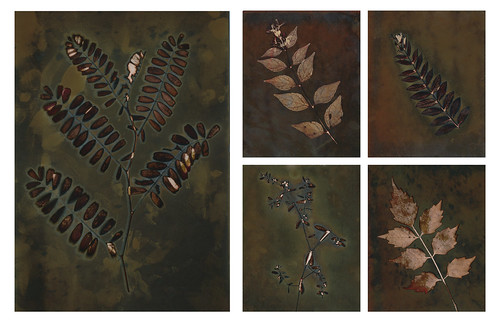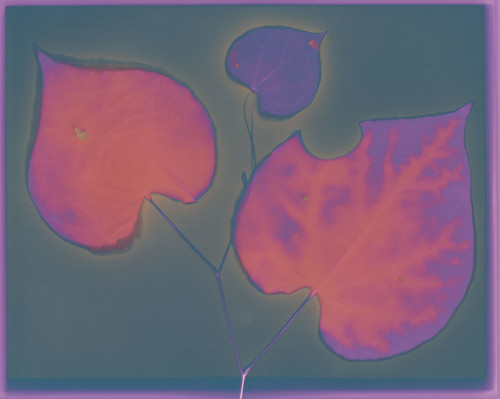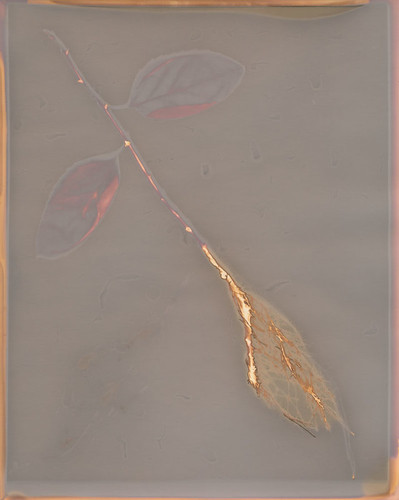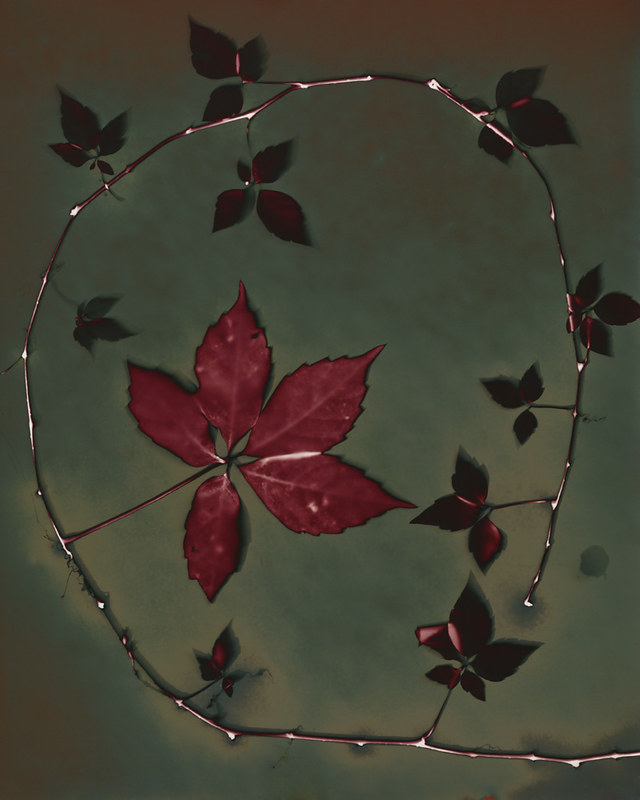I've used many different papers (and non-papers) for lumen printing. I generally try anything I can get my hands on, really. Admittedly, I don't have the deep pockets to chase down much in the way of discontinued or expired paper types. Occasionally I'm able to get samples of old papers from friends, co-workers or stockpiles at work (I always try to use old paper for demos, since the old paper is worthless for printing). I prefer buying smaller quantities, because quite honestly most papers I've tested for lumen prints are kinda boring.
There are some exceptions, and those exceptions are my favorite types of lumen papers. The ones that stand head-and-shoulders above the rest, laughing at their dull, boring colors while they strut around flashing their giant tails at everyone. My top three at the moment are
APP Collodio-Chloride POP,
Kodak Polymax II RC and
Adox Fine Print Variotone Warmtone. Shall we talk about why?
APP Collodio-Chloride POP
 |
| Multiple fixed images, all with fresh leaves. |
This one's still being made, just not being made
commercially. It's individually coated by one guy up in New York and it's
expensive: $6 a sheet for 8x10s. Sometimes he has "test quality" sheets that he sells for $3, but as he improves his techniques for production, that's becoming less commonly available. Its lumen characteristics are amazing. It has two distinct tonal phases and even fixes in a gorgeous way. I love working with it, but am forced to do so only for the most interesting subjects and compositions due to scarce supply. I tend to make fairly small prints (4x5, 3x3 or 2.5x3) because of the expense.
Color Palette (Short Exposure): For very short exposures (15 minutes or less) the paper turns scarlet red, with objects remaining white or shifting towards golds and creams.
Color Palette (Long Exposure): Eventually (generally 2-3 hours) the paper works its way through and ugly brown color and clears to reveal a deep green that ranges from olive to emerald. At this stage, objects have shifted to the earlier pinks and reds. I often use extended exposures (5+ hours) to create deep emerald fields with scarlet subjects.
Moisture Response: The paper reacts
very well to moisture, creating blue-silver metallic highlights that shine brilliantly in the light. Collodio-Chloride POP even fixes well. Once fixed, the paper will generally move from a smooth texture to a varigated surface that highlights even the tiniest flaws, scratches, fingerprints and smudges. The visual effect works out a lot better than the description, I promise.
Reaction to Fixing: When fixed, Collodio-Chloride prints tend to become even more metallic, taking on weathered copper and tarnished bronze shades. This is my
very favorite lumen surface to work with, but my least used because of how costly the paper is.
Further Flickr Examples: One, Two, Three
Kodak Polymax RC
 |
| Dry wild carrot blossom |
Since Kodak no longer makes any darkroom papers at all, this paper is hard to find. It wasn't discontinued very long ago, I'm still able to find papers from 2005. It can be found on eBay, though, and occasionally it's even fairly cheap. At one point it was an extremely common paper. That's where I get my supply of it. With a gorgeous color palette and an often reasonable price, this is my "old reliable" favorite paper.
Color Palette: As with most Kodak papers, the general range is warm, with a very distinct split between objects and the field. The field will start off light, a kind of creamy almond that can eventually darken down to a chocolate brown. Objects start from an initial flaming orange, then develop into scarlet reds with hints of red-violet or more pure maroon. It's a very striking paper.
Moisture Response: Very little, actually. Halos do form, but they tend to have little color effect. If the paper is
saturated with moisture during the exposure, though, there is a complete palette shift from tan field and red object to
green fields with yellow-orange objects. A similar response to
Fomalux RC Contact paper, with slightly more muted colors.
Reaction to Fixing: Again, this paper is typical of Kodak products. It does
not react well to fixing. It fades away, losing almost all color and shifting to a dull, greyish orange-tan. It's extremely unpleasant and I have ceased any fixing of prints made on this paper.
Further Flickr Examples: One, Two, Three
Adox Fine Print Variotone Warmtone FB
 |
| Fresh-cut Judas Tree leaves |
While Ilford's Warmtone FB paper has similar characteristics, this Adox paper has much brighter colors and more subtle tones.
I only recently discovered it, but I have fallen in love with it. It produces fairly boring results with dry subjects, so I strongly recommend using it only with fresh-cut plants. It is still being produced commercially, and is easily available from Freestyle. The only downside is that it's not cheap, and comes only in small packages. No where near as bad as the APP Collodio-Chloride, but still not cheap. I'm currently in love with the 25-pack I purchased as part of a new paper exploration splurge, but I still try to control myself and use it only for interesting leaves and well-composed images.
Color Palette: Without moisture, this paper tends to produce simple images. Predominately grey-blue-violet fields with brighter red-violet objects. It isn't ugly, but it is
nothing compared to the moisture response.
Moisture Reaction: Once you involve moisture, Adox FB Variotone Warmtone really comes alive. The moisture creates highlights of orange and yellow in the red-violet objects, making them stand out dramatically against the field, which can occasionally take on slight shades of green among the grey-blue-violets.
Reaction to Fixing: Untested. Warmtone paper normally fixes pretty well, but tends to change its appearance
completely, shifting to a whole new palette of colors. I'll experiment with this soon, since I got some fixer to play with over the summer instead of having to drive down to work.
Further Flickr Examples: One, Two, Three
















